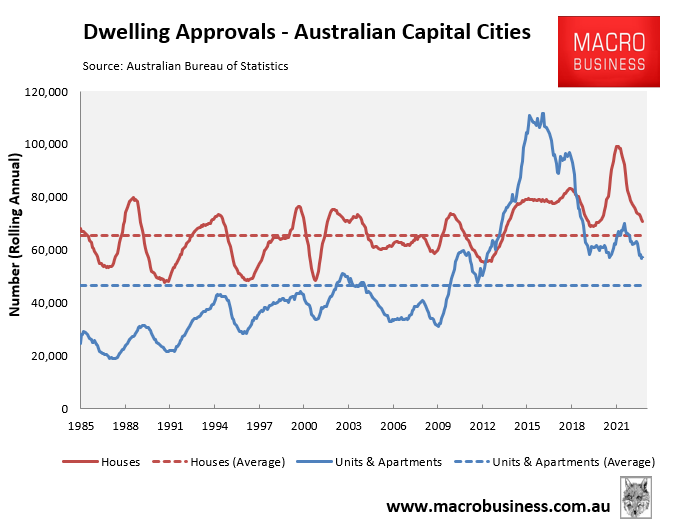YIMBYs, politicians, think tanks, the media, and developers are lobbying Australia to loosen planning laws so that hundreds of thousands of apartments can be built across the ‘missing middle’ of the nation’s major cities.
Their arguments dismiss ample empirical evidence showing the last decade’s high-rise apartment boom was a complete failure.

We saw a procession of reports on the problem of combustible and defective apartments across Australia’s cities in the run-up to the COVID-19 outbreak.
Building regulation consultant, Bronwyn Weir, warned an “enormous” problem has developed whereby “thousands and thousands of apartments have serious defects in their buildings”.
“Some of these buildings could potentially be a write-off”.
“We have what is now you know, a systemic failure that is quite difficult to unravel”, she said.
According to a poll conducted by the Strata Community Association NSW in October 2021, nearly four out of every ten new apartment complexes in NSW had major flaws.
A parliamentary inquiry in NSW uncovered significant structural flaws.
While similar systemic problems have been discovered across Melbourne, including leaking buildings and mould and faulty balconies.
To add insult to injury, The ABC last month reported that strata fees for Australian apartment owners are skyrocketing, costing owners thousands of dollars in extra payments.
Michael Teys, a strata expert, blamed the rising strata fees on soaring electricity and water expenses, building and maintenance work, and ballooning insurance costs.
“Insurance premiums have increased somewhere between 10% and 60% because of a range of factors, mainly due to the climate, but also due to building defect claims”, he said.
Teys said that strata fees in some complexes had increased by 40%.
“I think the very high increases that we’re seeing is partly to do with the fact that developers have a tendency to downplay the cost of levies when they’re selling the block”, he said.
Over the weekend, The SMH reported that apartment developers are also locking residents into expensive energy retailers.
In NSW, an estimated 95,400 households are connected to electricity-embedded networks, with another 64,000 connected to hot water-embedded networks.
That represents an increase of more than 900% over a decade whereby a retailer builds and owns the infrastructure to serve gas, electricity, or hot water.
According to a parliamentary report released late last year, users in some circumstances were paying more than double what their neighbours were paying and faced obstacles, taxes, and recurring costs if they attempted to transfer providers.
David Bannerman, principal of Sydney strata law firm Bannerman Lawyers, said embedded network contracts were expanding into “phenomenal” things like solar, air conditioning, potable water, hot and chilled water, internet access, stormwater, and waste removal systems, with retailers offering to build the infrastructure for free or at a low cost.
“People think that they’re buying an apartment and all the facilities that go with it … but the bottom line is the developer’s project cost is cut because they never paid for things that were necessary”, Bannerman said.
“What’s been allowed to proliferate is becoming commercialised nonsense”.
Liberal MP Ray Williams claimed “these guys are extortionists, they’ve created this false market to charge another cost to apartment owners”.
Let’s get real for a moment. These defective high-rise apartments would not have been built if the federal government did not choose to grow Australia’s population like a science experiment via extreme levels of immigration:

This massive immigration necessitated the construction of tens of thousands of additional dwellings each year, resulting in a focus on speed above quality and poor building standards.
The bulk of housing erected in Australia’s capital cities over the last decade were units and flats, as the first chart above shows.
The Albanese Government has now opened the floodgates to record levels of immigration, with 1.5 million net overseas migrants predicted to arrive in Australia by 2026-27, with the vast majority settling in major capital cities.
What will happen to building quality when we need to quickly increase housing supply to accommodate historic amounts of immigration? Will quality will remain stable, deteriorate, or improve?
The answer is self-evident: building standards will be lowered in order to build apartments as quickly as possible in order to house the soaring population.
More shoddy high-rise apartments will be developed in Australia’s cities to house the Albanese Government’s rash mass immigration policy.
Australia requires a productivity-driven economy that shares the gains. Not a stupid one focused on population that ruins the Australian way of life.
Unfortunately, our federal and state political elites have abandoned the idea of governing for the good of the Australian people.

